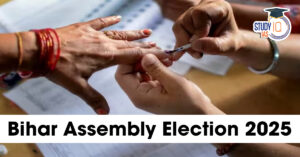Table of Contents
Evolution of Family Planning in India
- The program was launched to reduce birth rates and stabilize population growth, aligning with national economic needs.
- Over time, it expanded to include reproductive health and reduce maternal and child mortality rates.
- In 1966, a separate Department of Family Planning was established.
- In 1977, India’s Family Planning Department was renamed the Family Welfare Department after the government adopted a new population policy that emphasized voluntary participation in family planning.
- The National Population Policy (NPP) 2000 was established by the Government of India on February 15, 2000, as a comprehensive framework to address the challenges posed by rapid population growth. This policy aims to ensure sustainable development through responsible family planning and reproductive health services.
| Facts |
|
Awareness Initiatives
- World Vasectomy Day is observed annually on the third Friday of November (November 15 in 2024).
- In 2017, India observed a ‘vasectomy fortnight’ to raise awareness, debunk misconceptions, and encourage uptake.
- Mission Parivar Vikas: Launched in 2016, Mission Parivar Vikas (MPV) aims to improve access to contraceptives and family planning services in 146 high-fertility districts across 7 states (Bihar, Madhya Pradesh, Rajasthan, Uttar Pradesh, Chhattisgarh, Jharkhand, and Assam).
- Key initiatives include:
- Saarthi Vaahans: Mobile awareness campaigns.
- Saas Bahu Sammelens: Addressing social barriers for young women.
- Nayi Pahel Kits: Sensitizing newlyweds on family planning and responsible parenthood.
- A robust logistics system ensured uninterrupted contraceptive supplies, leading to a significant uptake of modern contraceptives.
- The success prompted the government to scale up MPV to all districts in these states and six North-Eastern states in 2021.
- Key initiatives include:
Ground Realities and Challenges
- Survey findings (Chhatrapati Sambhaji Nagar, Maharashtra, March 2024):
- Women perceive sterilisation as their responsibility and a belief that men should not be “burdened” by it as men’s work burden and financial loss due to a day’s wages forfeited for the procedure.
- Awareness of government-provided cash incentives for vasectomies is low.
- Barriers to vasectomy adoption:
- Illiteracy, male ego, misconceptions (e.g., its effect on libido), and family opposition.
- Lack of trained providers and limited knowledge among community health workers about no-scalpel vasectomies.
Recommendations and Solutions
- Early Sensitisation and Awareness Building: Introduce awareness programmes and peer discussions during adolescence in schools.
- Conduct social and behaviour change communication (SBCC) campaigns to dispel myths and destigmatise vasectomies.
- Enhanced Incentives: Increase conditional cash incentives for vasectomies to boost male participation.
- Examples:
- Maharashtra (2019): Men in rural tribal areas responded positively to incentives.
- Madhya Pradesh (2022): Increased vasectomy incentives by 50%.
- Examples:
- Lessons from International Success:
- South Korea: High vasectomy prevalence due to progressive norms and gender equality.
- Bhutan: Popularised vasectomies through social acceptance, government-run camps, and quality services.
- Brazil: Mass media awareness campaigns increased uptake from 8% in the 1980s to 5% in the last decade.
- Strengthening Health Systems: Train more health professionals to perform vasectomies.
- Invest in technical advancements like no-scalpel vasectomies.
- Align the national health system with policy objectives.
- Public Awareness Campaigns: Promote vasectomy as a safe and simple alternative to tubectomy.
- Ensure both partners make informed family planning decisions.


 Bihar Assembly Election 2025 Dates, Poli...
Bihar Assembly Election 2025 Dates, Poli...
 Bharat Bandh 9 July 2025: Over 25 Crore ...
Bharat Bandh 9 July 2025: Over 25 Crore ...
 Sukhoi Su-57: Will India Choose Russia�...
Sukhoi Su-57: Will India Choose Russia�...





















